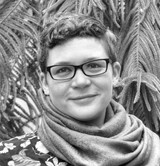Hanna Lucia Worliczek

Hanna Lucia Worliczek completed her studies in Biology at the University of Vienna in 2005, specializing in microbiology (Diploma thesis on the chemotaxonomic and molecular classification of bacteria). In 2010 she finished her dissertation in Microbiology/Genetics at the University of Vienna and the University of Veterinary Medicine Vienna (Doctoral thesis on the immune response of piglets to a protozoan parasite).
Between 2010 and 2014 she worked as a Postdoc at the Institute of Parasitology (University of Veterinary Medicine Vienna), leading a junior research group investigating the immunological host-parasite interactions between the protozoan parasite Cystoisospora suis and the pig, and working on the development of in vitro models. An additional focus was on cell biological research of the sexual stage formation by this parasite, mainly based on confocal microscopy studies of parasite development. Starting in 2011, she taught various aspects of Parasitology as well as Good Scientific Practice at the University of Veterinary Medicine Vienna (lectures, seminars, practical courses). Since October 2014, she has been enrolled in the DK Program ‘The Sciences in Historical, Philosophical and Cultural Contexts’ at the University of Vienna.
Research Project: Visual Evidence and Image Circulation – A History of the Argumentative Use of Fluorescence Microscopy Images in Cell Biology Research, 1970-1995
The phrase ‘seeing is believing’ properly underlines the importance of images in cell biology as a central piece of evidence and a research result essential for acquiring knowledge. Accordingly, microscopic images have become essential elements of publications in ultra-structural research since the 1950s, and are today regarded as ’data’. In the second half of the 20th century, the two principal imaging methods in cell biology research were fluorescence microscopy and electron microscopy. The latter was often referred to as a ‘gold standard’ and described as ’closer to nature‘ than other techniques. In contrast to light microscopy, it uses accelerated electrons as a source of illumination with a resolution limit below 1 nm. Although the first electron microscope was developed in 1932, it was not until 1950 that it became a standard technique, following the development of optimized preparation procedures for the objects of interest. Fluorescence microscopy on the other hand has – depending on the technique used – a resolution limit of 5-200 nm, making it possible to identify particular subcellular structures using specific fluorescent antibodies, which were developed in 1941, or – today – fluorescent proteins expressed by the cells under investigation. It was not until the 1970s that the combination of microscope and antibodies was applied to cell biological research. Both methods were used to produce visual evidence, and the images were presented as arguments in scientific publications. My project aims to reconstruct how the combination of fluorescence microscopy and antibodies constituted a new kind of visual knowledge (Bilderwissen) and interpretative practices within the field of cell biology, in competition with or complementary to the already established use of electron microscopy, as well as the development of publication practices and the circulation of this new kind of visual knowledge between 1970-1995.
UZA2/Rotunde - Althanstrasse 14, Ebene 3, Stiege H
1090 Wien
GPS: 48.23287, 16.358927
T: +43-1-4277-40872
F: +43-1-4277-40870




